Preparedness Challenge Week 6
The challenge this week is to add dry milk to your food storage.
Dry milk is convenient, easy to store, and can be used to replace liquid milk when it is in short supply or unavailable. It can also save you a trip to the grocery store. Use dry milk to make milk products like Greek yogurt and ricotta cheese and to add directly to baking mixes. There are four types of dry milk recommended for food storage.
What Are the Different Types of Dry Milk?
NONFAT DRY MILK
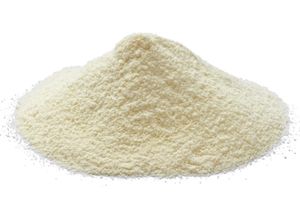
Nonfat dry milk is the most common form of dry milk used for food storage. In recent years, the drying process for making dry milk has been improved with lower temperatures and shorter drying periods, making it much more palatable and more like fresh milk, especially when stored properly.
Nonfat dry milk dissolves quickly and has the same nutrients as fresh skim milk. When it is refrigerated, it tastes like fresh skim milk. It is ideal to use in cooking and baking–just replace liquid milk with dry milk and water. Mix the dry milk with the other dry ingredients.
DRY WHOLE MILK
The fat in dry whole milk gives it a richer taste than nonfat dry milk, but it also gives it a shorter shelf life. Dry whole milk is common in parts of the world where refrigeration is not consistent. In America it is less available than nonfat dry milk. It can be substituted whenever whole milk is desired.
DRY BUTTERMILK
Cultured dry buttermilk is best used for baking. Use it to add flavor and to replace fresh buttermilk. It can be added directly to the dry ingredients.
HOT CHOCOLATE MIX
Hot chocolate mixes are loaded with sugar and may be made from whey and non-dairy creamer rather than real milk. In a crisis, a few extra calories from a hot chocolate mix might be welcome, but look for hot chocolate mixes made with dry milk rather than highly processed ingredients. Even better, make your own hot chocolate mix.
How Much Nonfat Dry Milk Should You Store?
This week the challenge is to add twenty pounds of nonfat dry milk to your food storage. Twenty pounds of nonfat dry milk will provide twenty-five gallons of milk, enough milk for each person in a family of four to have three glasses a day for a month.
To keep it simple, add 20 pounds of nonfat dry milk to your food storage.
Depending on the size of your family and your needs, you may want to adjust the amount of nonfat dry milk that you store. To figure out how much dry milk you need, begin by determining how many gallons of milk your family uses in a month. Four pounds of nonfat dry milk will make about five gallons of milk.
What Are the Best Packaging Options for Dry Milk?
MYLAR BAGS
The ideal packaging for dry milk is small Mylar bags with oxygen absorbers. The bags are opaque, durable, and convenient. Because the bags are small, if only part of the dry milk is used, there will only be a small amount of remaining milk exposed to air and moisture. Mylar bags are strong, but can puncture or tear, so store them in cardboard boxes or food storage buckets for added protection.
#10 CANS
Another option is to purchase and store dry milk in #10 cans with oxygen absorbers. Cans are opaque and durable. The cost of the can will increase the price slightly. Be sure to get plastic lids to protect the milk after the cans are opened.
FOOD STORAGE BUCKETS
You can also store dry milk in large, food-grade buckets. These buckets are made from HDPE plastic which is a good moisture barrier and a fair oxygen barrier. Food stored in them will have a shorter shelf life than if stored in Mylar bags or cans. To increase shelf life, use oxygen absorbers and lids with gasket seals. Once open, close buckets with gamma lids to help keep a tight seal.
What Is the Shelf Life of Dry Milk?
If stored in airtight containers in a cool, dark, and dry location, the “life-sustaining,” or functional shelf life of nonfat dry milk is twenty years. However, for optimum quality, and to ensure good tasting milk, nonfat dry milk should be used and replenished every three to five years. Once the package or container is open, the shelf life is about six months. The good news is that milk that has developed off-flavors can often still be used in cooking.
The shelf life of dry whole milk and dry buttermilk is about two years. Keep them refrigerated for a longer shelf life.
What Should You Look for When Purchasing Dry Milk?
CHECK THE NUTRITION FACTS LABEL
- Be sure you are purchasing 100% milk.
- Look for milk that is fortified with vitamins A and D.
- To be comparable to fresh milk, the serving size should contain at least 80 calories for nonfat dry milk and 140 calories for dry whole milk. (Beware of deceptive serving sizes.)
CHECK THE PACKAGING
- Be sure the packaging is impermeable to air, moisture, and light.
- Smaller pouches that make one or two gallons are a good option.
- Look for dry milk packaged with oxygen absorbers.
- Store open packages in an airtight container to limit moisture and oxidation.
SAMPLE BEFORE YOU PURCHASE LARGE QUANTITIES
- Before purchasing large quantities, sample the product you are considering purchasing.
- Chill thoroughly before evaluating the taste of instant dry milk.
- Be sure it has no off taste or smell.
- For fun, do a blind taste test with family members.
CALCULATE THE PRICE PER GALLON
- Before you purchase dry milk, calculate the price per gallon.
- Be aware that there is a wide variation in how much a gallon costs!
- The price per gallon of reconstituted dry milk should be about the same as for regular fresh milk.
Don’t Skip the Math! Don’t Be Deceived!
If you want to get the most for your food purchasing power, it’s important to compare prices.
You may think you want to skip the next step because you don’t want to bother with the math. I promise, I’ve made it very easy to compare prices. All you need is the calculator on your phone.
Or maybe you think that all nonfat dry milk costs about the same. Let me assure you it does not! I recently checked the price of ordinary instant nonfat dry milk sold by an MLM food company. Incredibly, when their product is reconstituted, it costs more than fifteen dollars a gallon!
How to Calculate the Price per Gallon of Reconstituted Dry Milk
Both nonfat and whole dry milk are sold by weight. Packages of dry milk vary in weight from package to package and brand to brand. Since fresh milk is commonly sold in gallons, it is helpful to use gallons as the unit of measure for comparing the price of reconstituted dry milk.
USE THE FOLLOWING STEPS TO DETERMINE THE PRICE PER GALLON OF MILK

- Step 1—Check the Nutrition Facts label on the package of dry milk and be sure the stated serving size contains at least 80 calories for nonfat and 140 for whole dry milk.
- Step 2—Consult the Nutrition Facts label to find out how many servings the package makes.
- Step 3—Multiply the number of servings times 8 to find the total number of ounces of milk the package will make. (There are 8 ounces in a one-cup serving.)
- Step 4—Divide the total ounces by 128 to find the number of gallons. (There are 128 ounces in a gallon.)
- Step 5—Divide the cost of the package by the number of gallons to find the cost per gallon.
- Step 6—The price per gallon should be close to the price per gallon of fresh milk.
The price per gallon for nonfat dry milk should be close to the price per gallon of fresh milk.
Recommendations for Where to Buy Nonfat Dry Milk
HOME STORAGE CENTERS
A good place to purchase nonfat dry milk is from the Home Storage Centers of the Church of Jesus Christ of Latter-Day Saints. You don’t have to be a church member to purchase from the Home Storage Centers. The milk is packaged in small Mylar pouches that make about two gallons of milk. Each serving has 100 calories, which is 25% more than other brands. When reconstituted, the price of nonfat dry milk is comparable to the price of fresh milk.
GROCERY STORE BRANDS
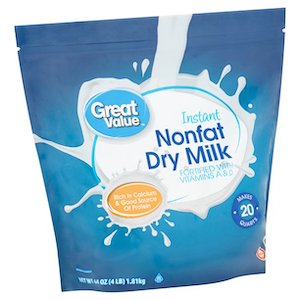
Grocery stores or warehouse stores that carry their own store brand are also good places to purchase nonfat dry milk. For example, Sam’s Club’s Member Mark brand, Walmart’s Great Value brand, and the Kroger’s Store brand have nonfat dry milk that is comparable to the price of fresh milk. The servings contain 80 calories and the milk is packaged in pouches.
THE INTERNET
I don’t recommend purchasing nonfat dry milk on internet sites unless you have confidence in the seller. Often, there is not a guarantee of the quality, and it’s common to see dry milk selling on Amazon and other internet stores that is equivalent to $10.00 or more a gallon! Buyer be ware.
Tips for Using Powdered Milk
MIX JUST WHAT YOU NEED
One nice thing about using dry milk is that you can mix exactly the amount of milk you need. When I want just a cup or so to make French toast or scrambled eggs, I like to use a Blender Bottle shaker jar to help reconstitute the milk. Its unique ball-like whisk helps quickly dissolve the dry milk, and the container is good for storing any remaining milk.
REFRIGERATE MILK FOR THE BEST TASTE
Powdered nonfat milk that has been mixed and then allowed it to blend and chill overnight is close to the taste of regular skim milk.
ADDITIONS TO IMPROVE THE TASTE OF NONFAT DRY MILK
If your family objects to the taste of skim milk, you can try to improve the taste by adding cream, sugar, powdered cream, vanilla, evaporated milk, or chocolate syrup, But frankly, trying to jazz it up is more bothersome than just getting used to it.
HOW CAN YOU HELP YOUR FAMILY GET USED TO NONFAT DRY MILK?

You may not be very enthusiastic about nonfat dry milk. And I know it can be hard to convince kids, or even yourself, to drink it. So how can you make it work for your family?
It took a while for our family to switch to skim milk. We were already drinking 2 percent, so we began by buying a gallon of fresh whole milk (4 percent butterfat) and mixing it with a gallon of nonfat dry milk. We gradually reduced the amount of whole milk until we were mixing a gallon of fresh whole milk with three gallons of nonfat dry milk. That turns out to be about 1 percent butterfat.
The Truth about Milk Alternatives
You may have seen milk alternatives marketed by food storage companies as a substitute for real milk. Take a careful look at the pros and cons before purchasing milk alternatives.
PROS
- Some people like the taste of milk alternatives—they have added sugar and are sweet.
- Milk alternatives have a shelf life of twenty to twenty-five years if packaged and stored properly.
CONS
- Milk alternatives are only suitable as a beverage and cannot be used in recipes as a substitute for regular milk.
- Milk alternatives are made from whey, non-dairy creamer, and other highly-processed ingredients.
- Milk alternatives are more expensive than nonfat dry milk. (One national food storage brand costs $13.00 a gallon!)
- Milk alternatives have fewer calories than nonfat dry milk.
- Some brands are lacking in vitamins A and D.
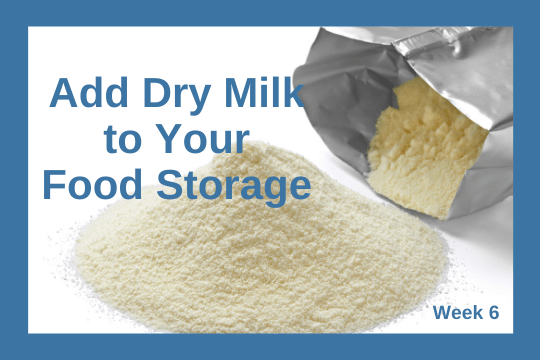
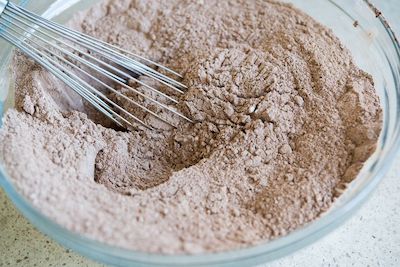
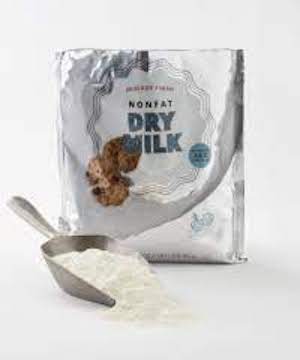
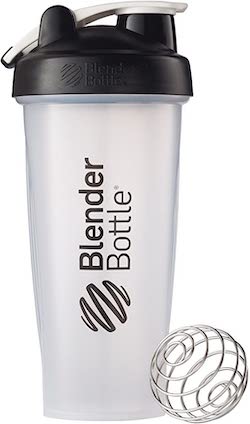


5 thoughts on “Tips for Adding Dry Milk to Your Food Storage”
I am lactose intolerant and cannot drink milk. What alternative can I use for an emergency supply?
Lynne, we are as well and we found a soy milk (powdered) from NOW brands on Amazon. They also have coconut milk and other types, but we needed something low-fat as well. I hope this helps!
This is great information. Thank you for bringing up the cost factor as there are many companies that are happy to take advantage of people who want to be prepared. Do the preparation on your own and save A LOT of money.
We have small toddlers. We bought some Nido as a whole milk substitute. Would this be ok?
Thank you for sharing your precious knowledge. Just the right information I needed. By the way, check out my website at YV6 about Thai-Massage.